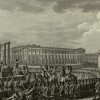Paris, France: Place de la Concorde (Place de la Révolution) - Reign of Terror
The Place de la Concorde is a public square in Paris, France. During the French Revolution, the square was renamed Place de la Révolution, and executions by guillotine were performed there, including the executions of King Louis XVI and Queen Marie Antoinette. In 1795, the name Place de la Révolution was changed back to its original Place de la Concorde in an attempt at reconciliation after the violence of the French Revolution. "The guillotine, particularly the one in Paris’s Place de la Révolution, served as the bloody emblem of the fear tactics that began to manifest themselves." (Piccitto) The Place de la Concorde is also known as the Place de la Révolution.
The Reign of Terror was an extremely violent period during the French Revolution. It began shortly after the French Revolution began. The Reign of Terror started on 5 September 1793 and ended on 28 July 1794. Some historians believe that the Reign of Terror started in March or June when the Revolutionary Tribunal was created. Some historians believe the beginning of the Reign of Terror was even earlier when the September Massacres occurred in 1792. Others believe the beginning of the Reign of Terror to be on July 1789, when the first killing of the revolution happened. Maximilien Robespierre was the man in leadership during the Reign of Terror. The fall and death of Maximilien Robespierre marked the end of the Reign of Terror. What's intriguing, and probably its own form of karmic justice is that Maximilien Robespierre was executed on the same guillotine that was located in the Place de la Concorde, where the people he was responsible for executing were put to death too.
By analyzing the effects of the French Revolution, one can conclude that Romanticism emerged as a response to the French Revolution. Instead of digging for the laws of nature and the logical side of humans, Romantics tried to have direct contact with nature. The French Revolution directly influenced Romantic artists and writers. The French Revolution and the Reign of Terror resulted in a fundamental change in society's function and ideals. Many Romantics accepted and approved of the French Revolution, often writing works expressing this perspective. William Wordsworth, Samuel Taylor Coleridge, Lord Byron, and Percy Shelley all shared this perspective and point of view. They all believed that the French Revolution marked a highly transformative experience, as it changed the ways of society and helped the oppressed. The French Revolution altered the lives of all French citizens. It had even impacted many other existing outside of France in the European continent, as it caused other countries to consider social reform, which greatly influenced literature and artwork. For instance, Lord Byron's poem "Darkness" was heavily influenced and inspired by the effects of war, and more specifically the French Revolution.
"On 5 September 1793, the National Convention, France’s ruling body from 1793 to 1795, officially put into effect terror measures in order to subdue opposition to and punish insufficient support for the revolution and the new regime. From the autumn of 1793 until the summer of 1794, thousands of people across the country were imprisoned and executed (including the Queen) under the ruthless leadership of Maximilien Robespierre. The guillotine, particularly the one in Paris’s Place de la Révolution, served as the bloody emblem of the fear tactics that began to manifest themselves first in the formation of the Committee of Public Safety (6 April 1793) and subsequently in the implementation of the Law of Suspects (17 September 1793). The Terror ended on 27 July 1794 with the overthrow of Robespierre, who was guillotined the next day." (Piccitto)
Sources:
Diane Piccitto, "On 1793 and the Aftermath of the French Revolution"
“Paris. (By Express on Saturday Evening.)'.” British Library, https://www.bl.uk/collection-items/newspaper-account-of-the-outbreak-of-....
“Reign of Terror.” BRANCH, https://www.branchcollective.org/?ps_event=reign-of-terror.
The Editors of Encyclopaedia Britannica. “Paul-François-Jean-Nicolas, Vicomte De Barras.” Encyclopædia Britannica, Encyclopædia Britannica, Inc., https://www.britannica.com/biography/Paul-Francois-Jean-Nicolas-vicomte-....
Parent Map
Coordinates
Longitude: 2.321235700000




